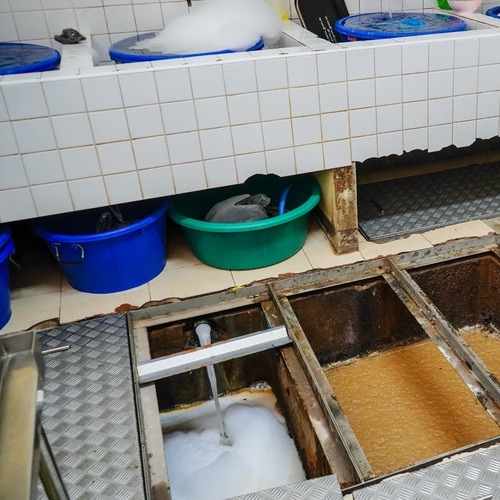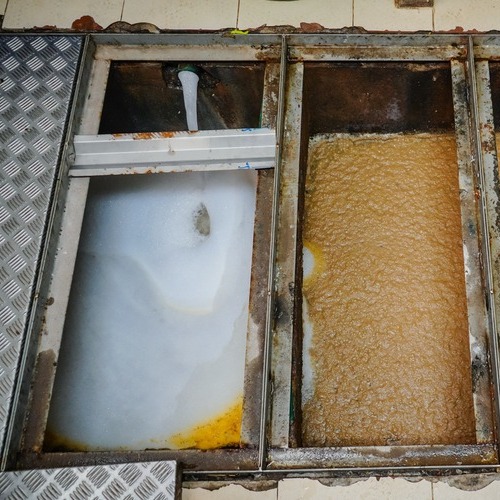
Keep Grease Trap Clean
For restaurant owners and kitchen managers, one thing you shouldn’t be without is experienced grease trap services. If you’re new to the business of managing, owning, or operating a kitchen, you know what a grease trap is, but for the dining customer, chances are you wouldn’t know, and why would you?
There is a lot that goes on in a commercial or industrial kitchen that the everyday diner wouldn’t know about, and just as well. But for the sake of setting a solid foundation for this article, let’s answer the basic question, “What is a grease trap?”, and then we’ll answer questions pertaining to grease trap services.
The name ‘grease trap’ says it all really. This device is something like a receptacle, technically referred to as an interceptor, that actually traps fats, oil, and grease, otherwise known in the industry as FOG. Kitchen wastewater flows through this receptacle or interceptor before that wastewater enters the sewer waste system. This receptacle captures the FOG and allows the water to proceed through the drain to the sewer system. This receptacle (or interceptor) is installed by a plumber that provides grease trap services.
What types of businesses typically need grease trap services?
Not every business is required to have a grease trap, such as a retail clothing store. The establishments that are required to have a grease trap include:
- Restaurants
- Food processing facilities
- Hotels
- Grocery stores
- Bakeries
These facilities are typically required to have grease traps installed and are inspected by local building code inspectors. This inspection is why having professional grease trap services is important.
What do grease trap services include?
Every commercial or industrial kitchen is required to have grease trap services performed for health and safety reasons. While an owner may be the DIY kind of owner, having this service performed by an experienced, licensed company is the better choice for several reasons, including following local building ordinances. The process will typically include the following steps:
- The FOG sludge layer is removed first using hand equipment and then the remaining waste is emptied.
- Next, the technician cleans the grease trap with water to remove any hardened grease that is stuck to the bottom and sides of the grease trap and empty it again.
- The grease trap services technicians will inspect the receptacle for issues like broken baffles and tee pipes, and broken manhole covers as if the receptacle has an excessive amount of grease and solids.
- Every step is recorded and a copy of those records is given to the owner or kitchen manager.
How often should a grease trap be serviced?
The frequency that a kitchen needs grease trap services will depend on three factors:
- The size of the grease trap.
- The volume of grease that is collected by the location.
- Local ordinance regulation and specifications.
With the three factors in consideration, it is recommended to set up a regular schedule for preventative grease trap maintenance. This will minimize unwanted backups and keeps the facility in line with local ordinances.
What are the benefits of having a grease trap?
A restaurant owner, manager, or staff knows there is a lot of FOG involved in a commercial or industrial kitchen that will end up going down the kitchen drain, and hopefully into the sewer lines. However, without a grease trap, that FOG would quickly create a clog and problems would abound in the kitchen. If you’re wondering what would happen if you skipped grease trap services, there are three key problems that having professional grease trap services can help a kitchen from having to experience are:
- Buildup Prevention
When too much FOG gets built up in the grease trap can cause the plumbing system to clog up. This will result in reduced function of the plumbing system. The regular emptying and cleaning of the grease trap will ensure the kitchen remains clean and safe.
- Environmentally Friendly
Without proper grease trap services, the fats, oil, and grease will begin seeping into the water lines and proceed into the local water supply. Having grease in the water supply is gross and creates a health hazard.
- Avoids Shut Down
When FOG backups happen, a problem that is common among commercial and industrial kitchens, and the FOG seeps into the water lines or backs up into the kitchen, this can result in the kitchen being shut down for repairs and cleanup.
Are there different levels or types of grease trap services?
A grease trap is not just a grease trap. There are three types of grease traps:
- Passive hydromechanical, aka manual
- Automatic
- Gravity
Within those three types, they are located inside the kitchen and outside the structure. The interior grease traps are typically found in the kitchen area close to the sink. This grease trap holds small amounts of FOG. The exterior grease trap is located just outside the building and is installed underground. This grease trap can hold up to thousands of gallons of FOG and wastewater that don’t make it to the sewer lines. Both the exterior and interior grease traps are serviced by professional grease trap services.
How long does a grease trap service take?
As long as the grease trap services technician can complete the cleaning process from the exterior grease trap, your staff, and customers often don’t realize they have come, cleaned, and left. The process can be completed in under 30 minutes in most cases.
However, if they find any issues or problems with the exterior portion and need to come inside, that could take longer. Hopefully, it is something they can schedule during non-business hours and have your kitchen back up and running.

Down To The Bottom Line: How much does a grease trap service cost?
There isn’t a set rate for grease trap services. Factors such as the size and number of grease traps a kitchen has will determine the cost of the service. As an owner or manager, getting quotes from several companies is recommended, and comparing what is included in their services. Need to set up grease trap services in Fort Pierce and Port St. Lucie, Fl? Schedule a service call at 800-330-7686.

